Brand Management Analysis: Starbucks and Optimum Impression Ltd
VerifiedAdded on 2021/01/02
|13
|5144
|196
Report
AI Summary
This report provides a detailed analysis of brand management, focusing on Starbucks and Optimum Impression Ltd. It begins with an introduction to brand management, brand equity, and the Customer-Based Brand Equity (CBBE) model. Task 1 examines an article from Optimum Impression Ltd., discussing brand building strategies and the importance of branding. Task 2 delves into Starbucks' brand portfolio strategies, including active and passive portfolio management, and utilizes the Boston Matrix to analyze its product lines. Task 3 assesses Starbucks' strengths, weaknesses, and collaborative agreements. Finally, Task 4 evaluates brand value, awareness, market share, consumer attitudes, and purchasing intent. The report incorporates concepts such as brand identity, meaning, response, and resonance, providing a comprehensive overview of brand management principles and their application in the real world.
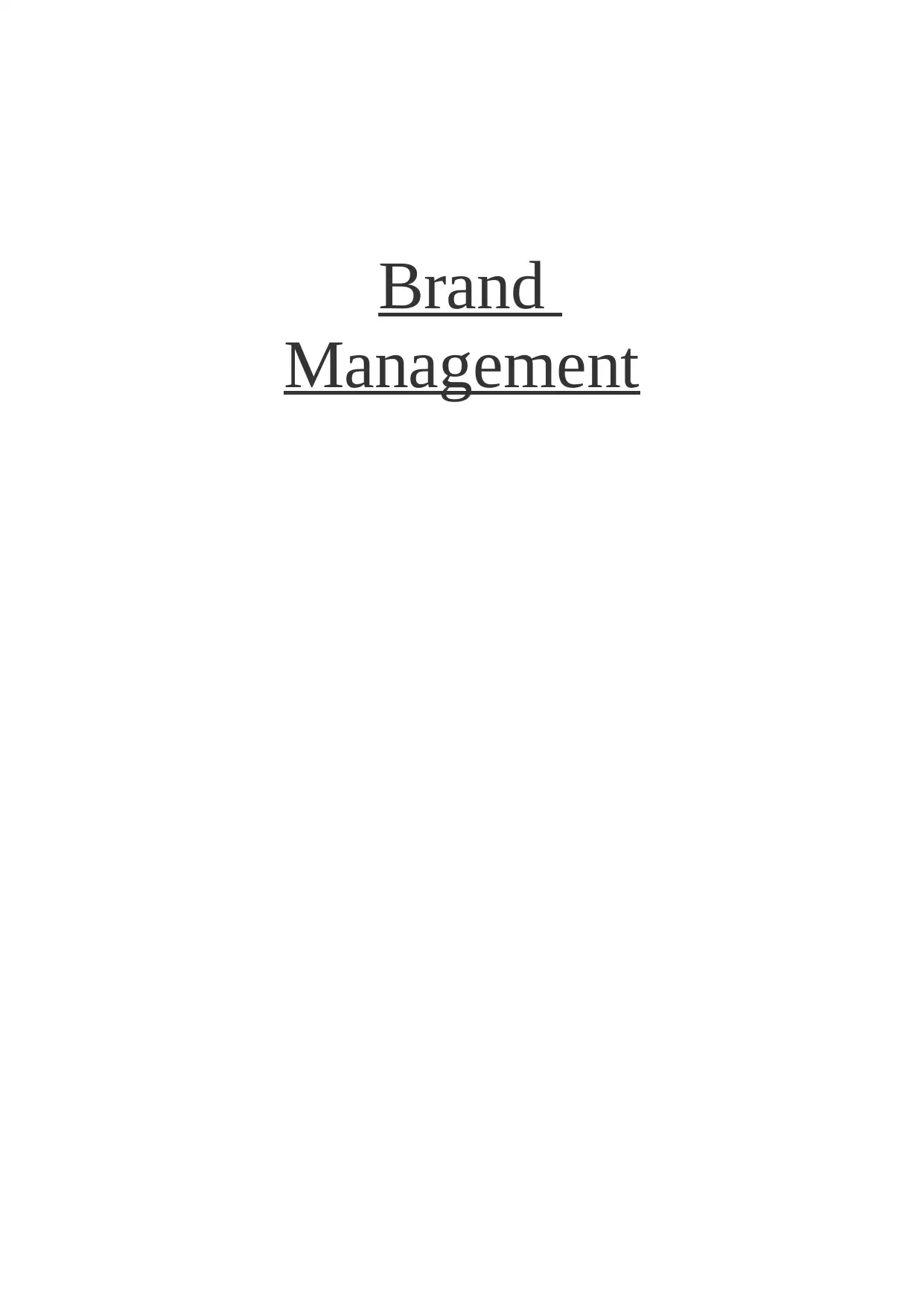
Brand
Management
Management
Paraphrase This Document
Need a fresh take? Get an instant paraphrase of this document with our AI Paraphraser
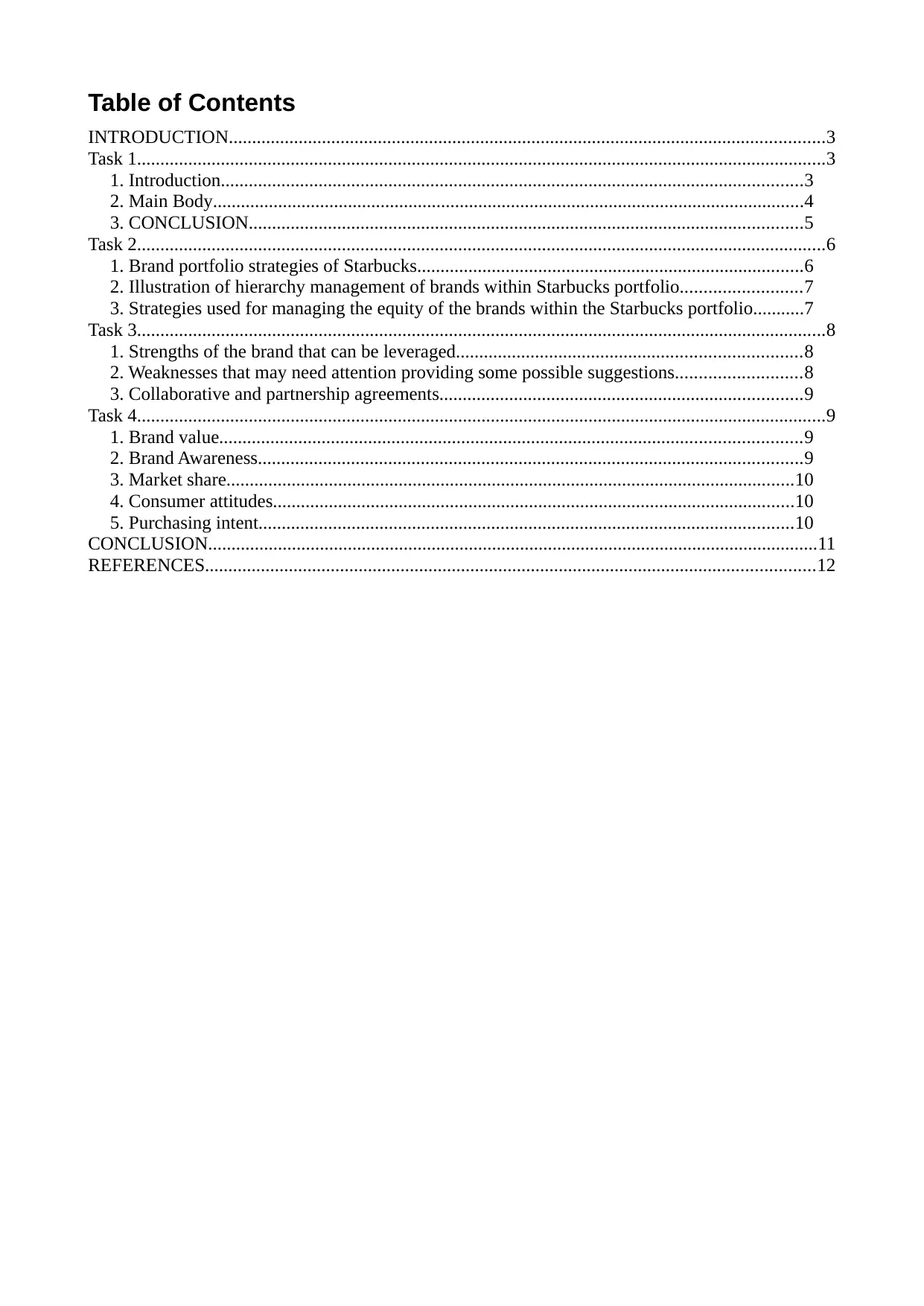
Table of Contents
INTRODUCTION................................................................................................................................3
Task 1....................................................................................................................................................3
1. Introduction.............................................................................................................................3
2. Main Body...............................................................................................................................4
3. CONCLUSION.......................................................................................................................5
Task 2....................................................................................................................................................6
1. Brand portfolio strategies of Starbucks...................................................................................6
2. Illustration of hierarchy management of brands within Starbucks portfolio..........................7
3. Strategies used for managing the equity of the brands within the Starbucks portfolio...........7
Task 3....................................................................................................................................................8
1. Strengths of the brand that can be leveraged..........................................................................8
2. Weaknesses that may need attention providing some possible suggestions...........................8
3. Collaborative and partnership agreements..............................................................................9
Task 4....................................................................................................................................................9
1. Brand value.............................................................................................................................9
2. Brand Awareness.....................................................................................................................9
3. Market share..........................................................................................................................10
4. Consumer attitudes................................................................................................................10
5. Purchasing intent...................................................................................................................10
CONCLUSION...................................................................................................................................11
REFERENCES...................................................................................................................................12
INTRODUCTION................................................................................................................................3
Task 1....................................................................................................................................................3
1. Introduction.............................................................................................................................3
2. Main Body...............................................................................................................................4
3. CONCLUSION.......................................................................................................................5
Task 2....................................................................................................................................................6
1. Brand portfolio strategies of Starbucks...................................................................................6
2. Illustration of hierarchy management of brands within Starbucks portfolio..........................7
3. Strategies used for managing the equity of the brands within the Starbucks portfolio...........7
Task 3....................................................................................................................................................8
1. Strengths of the brand that can be leveraged..........................................................................8
2. Weaknesses that may need attention providing some possible suggestions...........................8
3. Collaborative and partnership agreements..............................................................................9
Task 4....................................................................................................................................................9
1. Brand value.............................................................................................................................9
2. Brand Awareness.....................................................................................................................9
3. Market share..........................................................................................................................10
4. Consumer attitudes................................................................................................................10
5. Purchasing intent...................................................................................................................10
CONCLUSION...................................................................................................................................11
REFERENCES...................................................................................................................................12
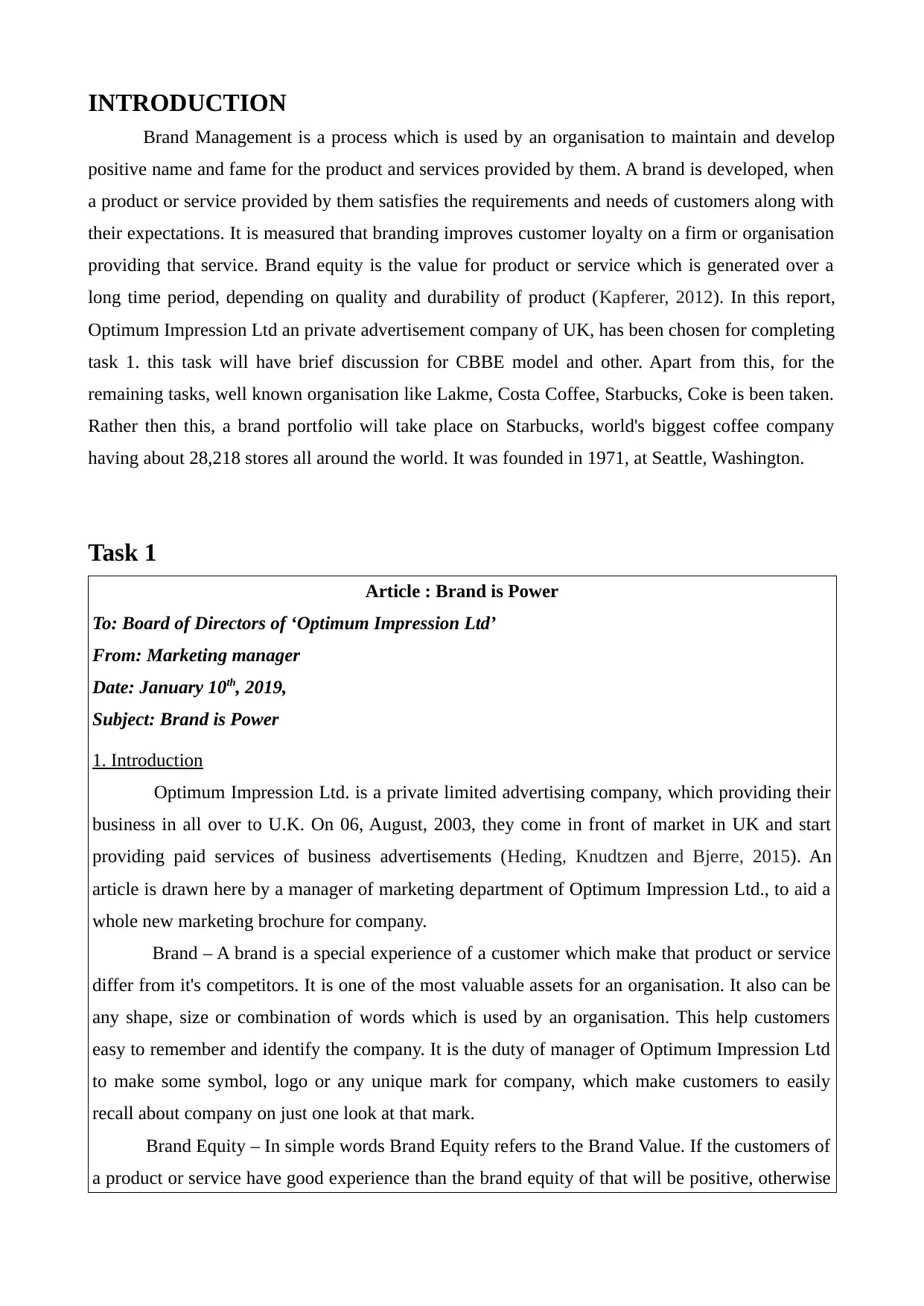
INTRODUCTION
Brand Management is a process which is used by an organisation to maintain and develop
positive name and fame for the product and services provided by them. A brand is developed, when
a product or service provided by them satisfies the requirements and needs of customers along with
their expectations. It is measured that branding improves customer loyalty on a firm or organisation
providing that service. Brand equity is the value for product or service which is generated over a
long time period, depending on quality and durability of product (Kapferer, 2012). In this report,
Optimum Impression Ltd an private advertisement company of UK, has been chosen for completing
task 1. this task will have brief discussion for CBBE model and other. Apart from this, for the
remaining tasks, well known organisation like Lakme, Costa Coffee, Starbucks, Coke is been taken.
Rather then this, a brand portfolio will take place on Starbucks, world's biggest coffee company
having about 28,218 stores all around the world. It was founded in 1971, at Seattle, Washington.
Task 1
Article : Brand is Power
To: Board of Directors of ‘Optimum Impression Ltd’
From: Marketing manager
Date: January 10th, 2019,
Subject: Brand is Power
1. Introduction
Optimum Impression Ltd. is a private limited advertising company, which providing their
business in all over to U.K. On 06, August, 2003, they come in front of market in UK and start
providing paid services of business advertisements (Heding, Knudtzen and Bjerre, 2015). An
article is drawn here by a manager of marketing department of Optimum Impression Ltd., to aid a
whole new marketing brochure for company.
Brand – A brand is a special experience of a customer which make that product or service
differ from it's competitors. It is one of the most valuable assets for an organisation. It also can be
any shape, size or combination of words which is used by an organisation. This help customers
easy to remember and identify the company. It is the duty of manager of Optimum Impression Ltd
to make some symbol, logo or any unique mark for company, which make customers to easily
recall about company on just one look at that mark.
Brand Equity – In simple words Brand Equity refers to the Brand Value. If the customers of
a product or service have good experience than the brand equity of that will be positive, otherwise
Brand Management is a process which is used by an organisation to maintain and develop
positive name and fame for the product and services provided by them. A brand is developed, when
a product or service provided by them satisfies the requirements and needs of customers along with
their expectations. It is measured that branding improves customer loyalty on a firm or organisation
providing that service. Brand equity is the value for product or service which is generated over a
long time period, depending on quality and durability of product (Kapferer, 2012). In this report,
Optimum Impression Ltd an private advertisement company of UK, has been chosen for completing
task 1. this task will have brief discussion for CBBE model and other. Apart from this, for the
remaining tasks, well known organisation like Lakme, Costa Coffee, Starbucks, Coke is been taken.
Rather then this, a brand portfolio will take place on Starbucks, world's biggest coffee company
having about 28,218 stores all around the world. It was founded in 1971, at Seattle, Washington.
Task 1
Article : Brand is Power
To: Board of Directors of ‘Optimum Impression Ltd’
From: Marketing manager
Date: January 10th, 2019,
Subject: Brand is Power
1. Introduction
Optimum Impression Ltd. is a private limited advertising company, which providing their
business in all over to U.K. On 06, August, 2003, they come in front of market in UK and start
providing paid services of business advertisements (Heding, Knudtzen and Bjerre, 2015). An
article is drawn here by a manager of marketing department of Optimum Impression Ltd., to aid a
whole new marketing brochure for company.
Brand – A brand is a special experience of a customer which make that product or service
differ from it's competitors. It is one of the most valuable assets for an organisation. It also can be
any shape, size or combination of words which is used by an organisation. This help customers
easy to remember and identify the company. It is the duty of manager of Optimum Impression Ltd
to make some symbol, logo or any unique mark for company, which make customers to easily
recall about company on just one look at that mark.
Brand Equity – In simple words Brand Equity refers to the Brand Value. If the customers of
a product or service have good experience than the brand equity of that will be positive, otherwise
⊘ This is a preview!⊘
Do you want full access?
Subscribe today to unlock all pages.

Trusted by 1+ million students worldwide
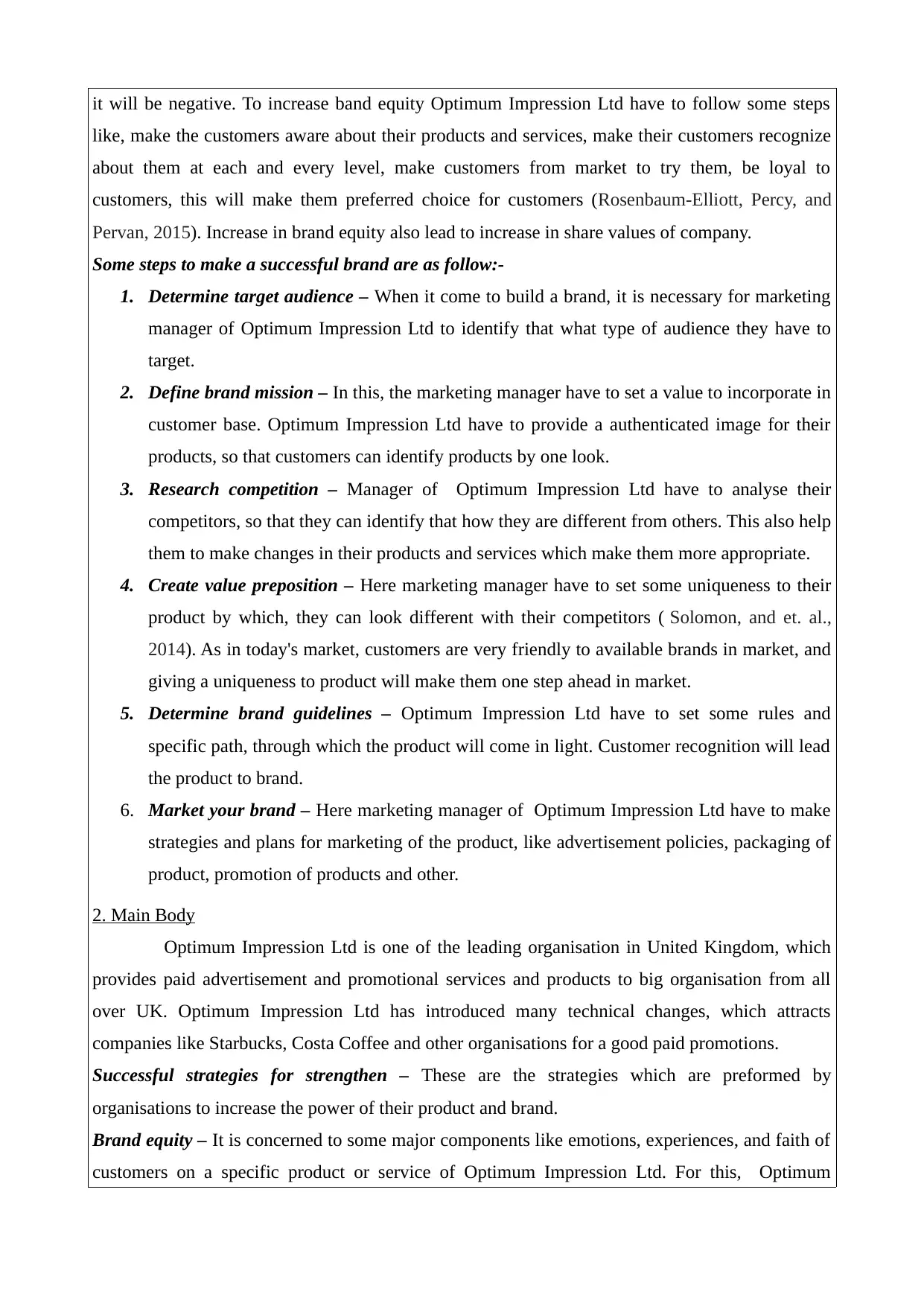
it will be negative. To increase band equity Optimum Impression Ltd have to follow some steps
like, make the customers aware about their products and services, make their customers recognize
about them at each and every level, make customers from market to try them, be loyal to
customers, this will make them preferred choice for customers (Rosenbaum-Elliott, Percy, and
Pervan, 2015). Increase in brand equity also lead to increase in share values of company.
Some steps to make a successful brand are as follow:-
1. Determine target audience – When it come to build a brand, it is necessary for marketing
manager of Optimum Impression Ltd to identify that what type of audience they have to
target.
2. Define brand mission – In this, the marketing manager have to set a value to incorporate in
customer base. Optimum Impression Ltd have to provide a authenticated image for their
products, so that customers can identify products by one look.
3. Research competition – Manager of Optimum Impression Ltd have to analyse their
competitors, so that they can identify that how they are different from others. This also help
them to make changes in their products and services which make them more appropriate.
4. Create value preposition – Here marketing manager have to set some uniqueness to their
product by which, they can look different with their competitors ( Solomon, and et. al.,
2014). As in today's market, customers are very friendly to available brands in market, and
giving a uniqueness to product will make them one step ahead in market.
5. Determine brand guidelines – Optimum Impression Ltd have to set some rules and
specific path, through which the product will come in light. Customer recognition will lead
the product to brand.
6. Market your brand – Here marketing manager of Optimum Impression Ltd have to make
strategies and plans for marketing of the product, like advertisement policies, packaging of
product, promotion of products and other.
2. Main Body
Optimum Impression Ltd is one of the leading organisation in United Kingdom, which
provides paid advertisement and promotional services and products to big organisation from all
over UK. Optimum Impression Ltd has introduced many technical changes, which attracts
companies like Starbucks, Costa Coffee and other organisations for a good paid promotions.
Successful strategies for strengthen – These are the strategies which are preformed by
organisations to increase the power of their product and brand.
Brand equity – It is concerned to some major components like emotions, experiences, and faith of
customers on a specific product or service of Optimum Impression Ltd. For this, Optimum
like, make the customers aware about their products and services, make their customers recognize
about them at each and every level, make customers from market to try them, be loyal to
customers, this will make them preferred choice for customers (Rosenbaum-Elliott, Percy, and
Pervan, 2015). Increase in brand equity also lead to increase in share values of company.
Some steps to make a successful brand are as follow:-
1. Determine target audience – When it come to build a brand, it is necessary for marketing
manager of Optimum Impression Ltd to identify that what type of audience they have to
target.
2. Define brand mission – In this, the marketing manager have to set a value to incorporate in
customer base. Optimum Impression Ltd have to provide a authenticated image for their
products, so that customers can identify products by one look.
3. Research competition – Manager of Optimum Impression Ltd have to analyse their
competitors, so that they can identify that how they are different from others. This also help
them to make changes in their products and services which make them more appropriate.
4. Create value preposition – Here marketing manager have to set some uniqueness to their
product by which, they can look different with their competitors ( Solomon, and et. al.,
2014). As in today's market, customers are very friendly to available brands in market, and
giving a uniqueness to product will make them one step ahead in market.
5. Determine brand guidelines – Optimum Impression Ltd have to set some rules and
specific path, through which the product will come in light. Customer recognition will lead
the product to brand.
6. Market your brand – Here marketing manager of Optimum Impression Ltd have to make
strategies and plans for marketing of the product, like advertisement policies, packaging of
product, promotion of products and other.
2. Main Body
Optimum Impression Ltd is one of the leading organisation in United Kingdom, which
provides paid advertisement and promotional services and products to big organisation from all
over UK. Optimum Impression Ltd has introduced many technical changes, which attracts
companies like Starbucks, Costa Coffee and other organisations for a good paid promotions.
Successful strategies for strengthen – These are the strategies which are preformed by
organisations to increase the power of their product and brand.
Brand equity – It is concerned to some major components like emotions, experiences, and faith of
customers on a specific product or service of Optimum Impression Ltd. For this, Optimum
Paraphrase This Document
Need a fresh take? Get an instant paraphrase of this document with our AI Paraphraser
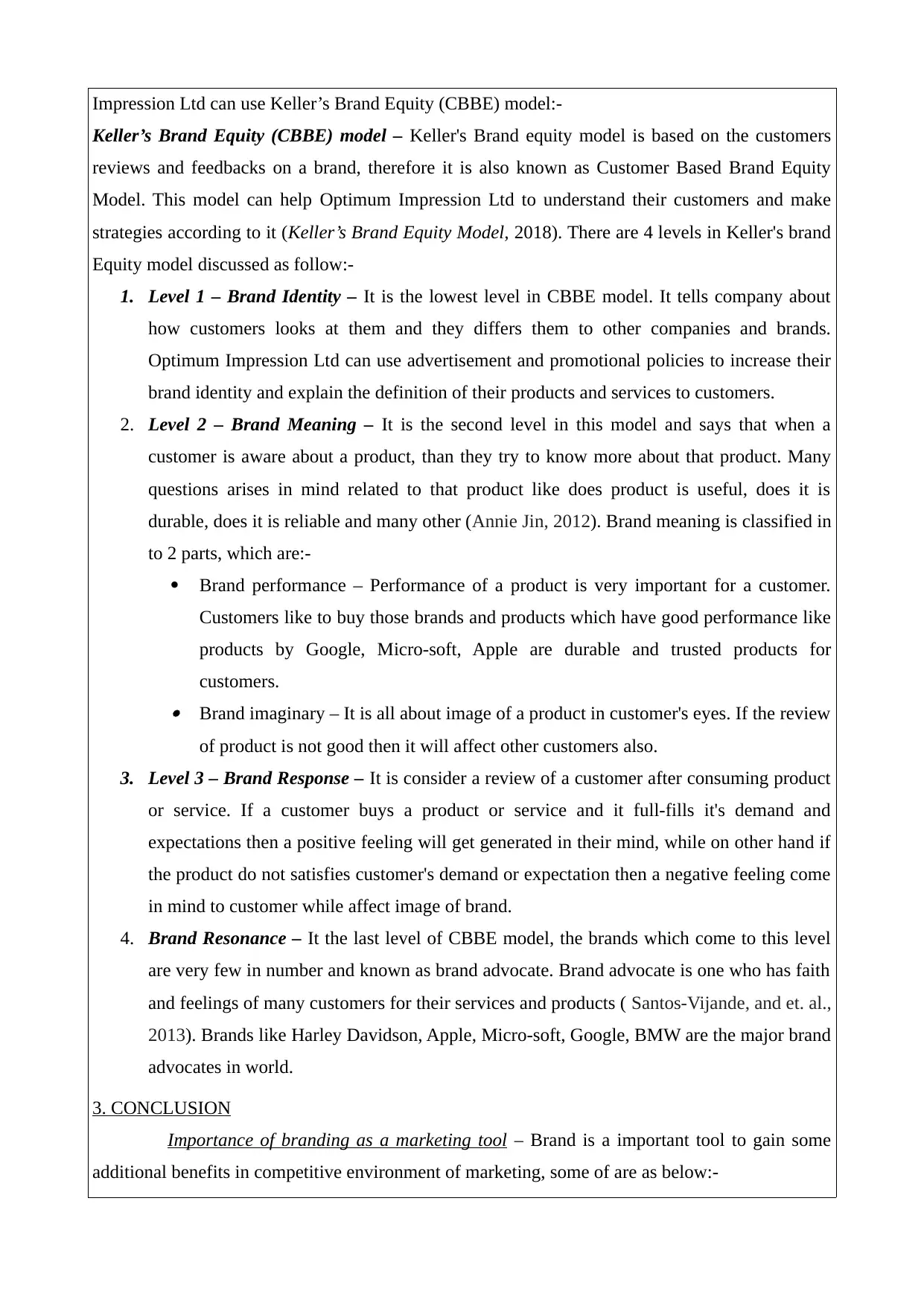
Impression Ltd can use Keller’s Brand Equity (CBBE) model:-
Keller’s Brand Equity (CBBE) model – Keller's Brand equity model is based on the customers
reviews and feedbacks on a brand, therefore it is also known as Customer Based Brand Equity
Model. This model can help Optimum Impression Ltd to understand their customers and make
strategies according to it (Keller’s Brand Equity Model, 2018). There are 4 levels in Keller's brand
Equity model discussed as follow:-
1. Level 1 – Brand Identity – It is the lowest level in CBBE model. It tells company about
how customers looks at them and they differs them to other companies and brands.
Optimum Impression Ltd can use advertisement and promotional policies to increase their
brand identity and explain the definition of their products and services to customers.
2. Level 2 – Brand Meaning – It is the second level in this model and says that when a
customer is aware about a product, than they try to know more about that product. Many
questions arises in mind related to that product like does product is useful, does it is
durable, does it is reliable and many other (Annie Jin, 2012). Brand meaning is classified in
to 2 parts, which are:-
Brand performance – Performance of a product is very important for a customer.
Customers like to buy those brands and products which have good performance like
products by Google, Micro-soft, Apple are durable and trusted products for
customers.
Brand imaginary – It is all about image of a product in customer's eyes. If the review
of product is not good then it will affect other customers also.
3. Level 3 – Brand Response – It is consider a review of a customer after consuming product
or service. If a customer buys a product or service and it full-fills it's demand and
expectations then a positive feeling will get generated in their mind, while on other hand if
the product do not satisfies customer's demand or expectation then a negative feeling come
in mind to customer while affect image of brand.
4. Brand Resonance – It the last level of CBBE model, the brands which come to this level
are very few in number and known as brand advocate. Brand advocate is one who has faith
and feelings of many customers for their services and products ( Santos-Vijande, and et. al.,
2013). Brands like Harley Davidson, Apple, Micro-soft, Google, BMW are the major brand
advocates in world.
3. CONCLUSION
Importance of branding as a marketing tool – Brand is a important tool to gain some
additional benefits in competitive environment of marketing, some of are as below:-
Keller’s Brand Equity (CBBE) model – Keller's Brand equity model is based on the customers
reviews and feedbacks on a brand, therefore it is also known as Customer Based Brand Equity
Model. This model can help Optimum Impression Ltd to understand their customers and make
strategies according to it (Keller’s Brand Equity Model, 2018). There are 4 levels in Keller's brand
Equity model discussed as follow:-
1. Level 1 – Brand Identity – It is the lowest level in CBBE model. It tells company about
how customers looks at them and they differs them to other companies and brands.
Optimum Impression Ltd can use advertisement and promotional policies to increase their
brand identity and explain the definition of their products and services to customers.
2. Level 2 – Brand Meaning – It is the second level in this model and says that when a
customer is aware about a product, than they try to know more about that product. Many
questions arises in mind related to that product like does product is useful, does it is
durable, does it is reliable and many other (Annie Jin, 2012). Brand meaning is classified in
to 2 parts, which are:-
Brand performance – Performance of a product is very important for a customer.
Customers like to buy those brands and products which have good performance like
products by Google, Micro-soft, Apple are durable and trusted products for
customers.
Brand imaginary – It is all about image of a product in customer's eyes. If the review
of product is not good then it will affect other customers also.
3. Level 3 – Brand Response – It is consider a review of a customer after consuming product
or service. If a customer buys a product or service and it full-fills it's demand and
expectations then a positive feeling will get generated in their mind, while on other hand if
the product do not satisfies customer's demand or expectation then a negative feeling come
in mind to customer while affect image of brand.
4. Brand Resonance – It the last level of CBBE model, the brands which come to this level
are very few in number and known as brand advocate. Brand advocate is one who has faith
and feelings of many customers for their services and products ( Santos-Vijande, and et. al.,
2013). Brands like Harley Davidson, Apple, Micro-soft, Google, BMW are the major brand
advocates in world.
3. CONCLUSION
Importance of branding as a marketing tool – Brand is a important tool to gain some
additional benefits in competitive environment of marketing, some of are as below:-
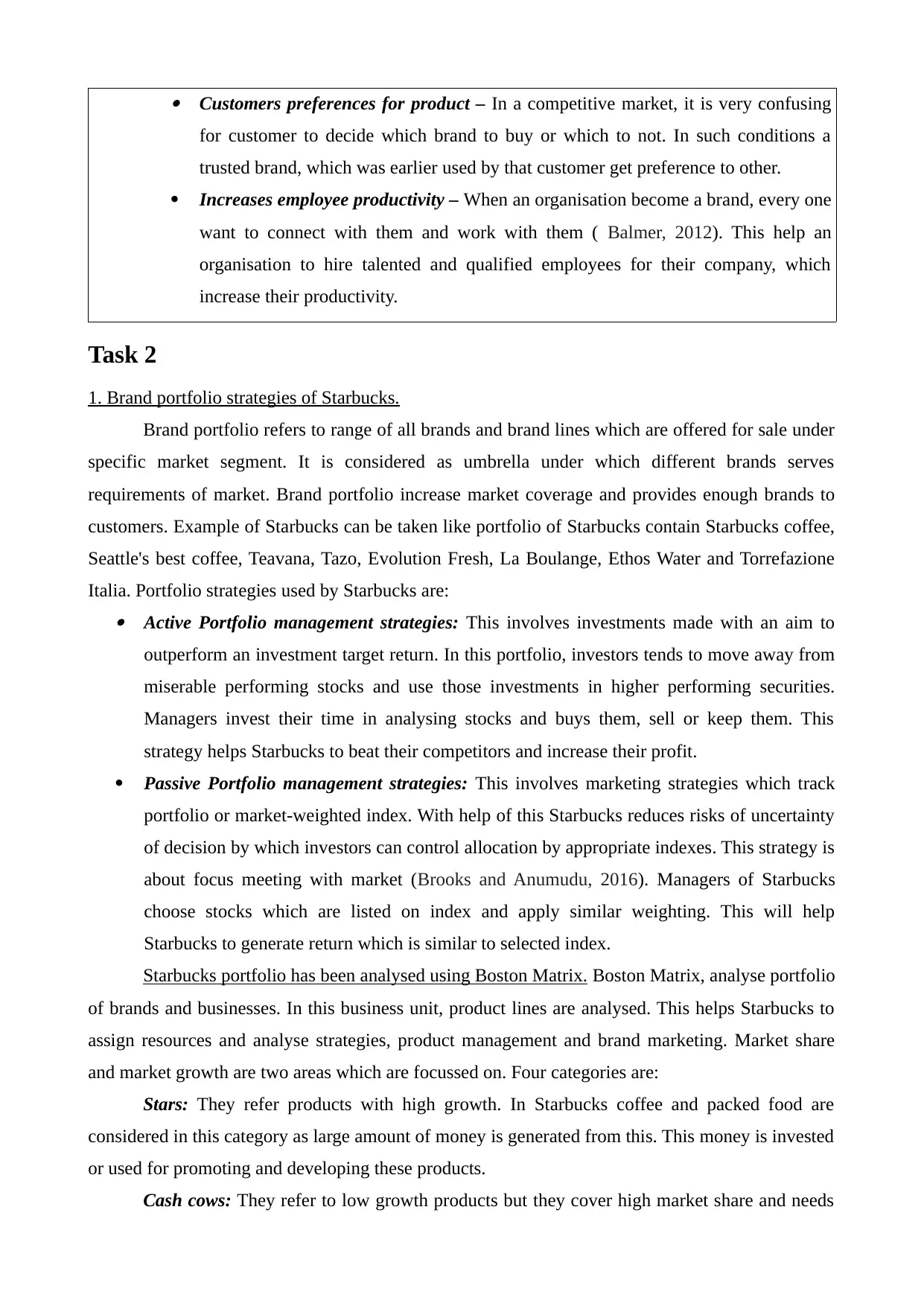
Customers preferences for product – In a competitive market, it is very confusing
for customer to decide which brand to buy or which to not. In such conditions a
trusted brand, which was earlier used by that customer get preference to other.
Increases employee productivity – When an organisation become a brand, every one
want to connect with them and work with them ( Balmer, 2012). This help an
organisation to hire talented and qualified employees for their company, which
increase their productivity.
Task 2
1. Brand portfolio strategies of Starbucks.
Brand portfolio refers to range of all brands and brand lines which are offered for sale under
specific market segment. It is considered as umbrella under which different brands serves
requirements of market. Brand portfolio increase market coverage and provides enough brands to
customers. Example of Starbucks can be taken like portfolio of Starbucks contain Starbucks coffee,
Seattle's best coffee, Teavana, Tazo, Evolution Fresh, La Boulange, Ethos Water and Torrefazione
Italia. Portfolio strategies used by Starbucks are: Active Portfolio management strategies: This involves investments made with an aim to
outperform an investment target return. In this portfolio, investors tends to move away from
miserable performing stocks and use those investments in higher performing securities.
Managers invest their time in analysing stocks and buys them, sell or keep them. This
strategy helps Starbucks to beat their competitors and increase their profit.
Passive Portfolio management strategies: This involves marketing strategies which track
portfolio or market-weighted index. With help of this Starbucks reduces risks of uncertainty
of decision by which investors can control allocation by appropriate indexes. This strategy is
about focus meeting with market (Brooks and Anumudu, 2016). Managers of Starbucks
choose stocks which are listed on index and apply similar weighting. This will help
Starbucks to generate return which is similar to selected index.
Starbucks portfolio has been analysed using Boston Matrix. Boston Matrix, analyse portfolio
of brands and businesses. In this business unit, product lines are analysed. This helps Starbucks to
assign resources and analyse strategies, product management and brand marketing. Market share
and market growth are two areas which are focussed on. Four categories are:
Stars: They refer products with high growth. In Starbucks coffee and packed food are
considered in this category as large amount of money is generated from this. This money is invested
or used for promoting and developing these products.
Cash cows: They refer to low growth products but they cover high market share and needs
for customer to decide which brand to buy or which to not. In such conditions a
trusted brand, which was earlier used by that customer get preference to other.
Increases employee productivity – When an organisation become a brand, every one
want to connect with them and work with them ( Balmer, 2012). This help an
organisation to hire talented and qualified employees for their company, which
increase their productivity.
Task 2
1. Brand portfolio strategies of Starbucks.
Brand portfolio refers to range of all brands and brand lines which are offered for sale under
specific market segment. It is considered as umbrella under which different brands serves
requirements of market. Brand portfolio increase market coverage and provides enough brands to
customers. Example of Starbucks can be taken like portfolio of Starbucks contain Starbucks coffee,
Seattle's best coffee, Teavana, Tazo, Evolution Fresh, La Boulange, Ethos Water and Torrefazione
Italia. Portfolio strategies used by Starbucks are: Active Portfolio management strategies: This involves investments made with an aim to
outperform an investment target return. In this portfolio, investors tends to move away from
miserable performing stocks and use those investments in higher performing securities.
Managers invest their time in analysing stocks and buys them, sell or keep them. This
strategy helps Starbucks to beat their competitors and increase their profit.
Passive Portfolio management strategies: This involves marketing strategies which track
portfolio or market-weighted index. With help of this Starbucks reduces risks of uncertainty
of decision by which investors can control allocation by appropriate indexes. This strategy is
about focus meeting with market (Brooks and Anumudu, 2016). Managers of Starbucks
choose stocks which are listed on index and apply similar weighting. This will help
Starbucks to generate return which is similar to selected index.
Starbucks portfolio has been analysed using Boston Matrix. Boston Matrix, analyse portfolio
of brands and businesses. In this business unit, product lines are analysed. This helps Starbucks to
assign resources and analyse strategies, product management and brand marketing. Market share
and market growth are two areas which are focussed on. Four categories are:
Stars: They refer products with high growth. In Starbucks coffee and packed food are
considered in this category as large amount of money is generated from this. This money is invested
or used for promoting and developing these products.
Cash cows: They refer to low growth products but they cover high market share and needs
⊘ This is a preview!⊘
Do you want full access?
Subscribe today to unlock all pages.

Trusted by 1+ million students worldwide
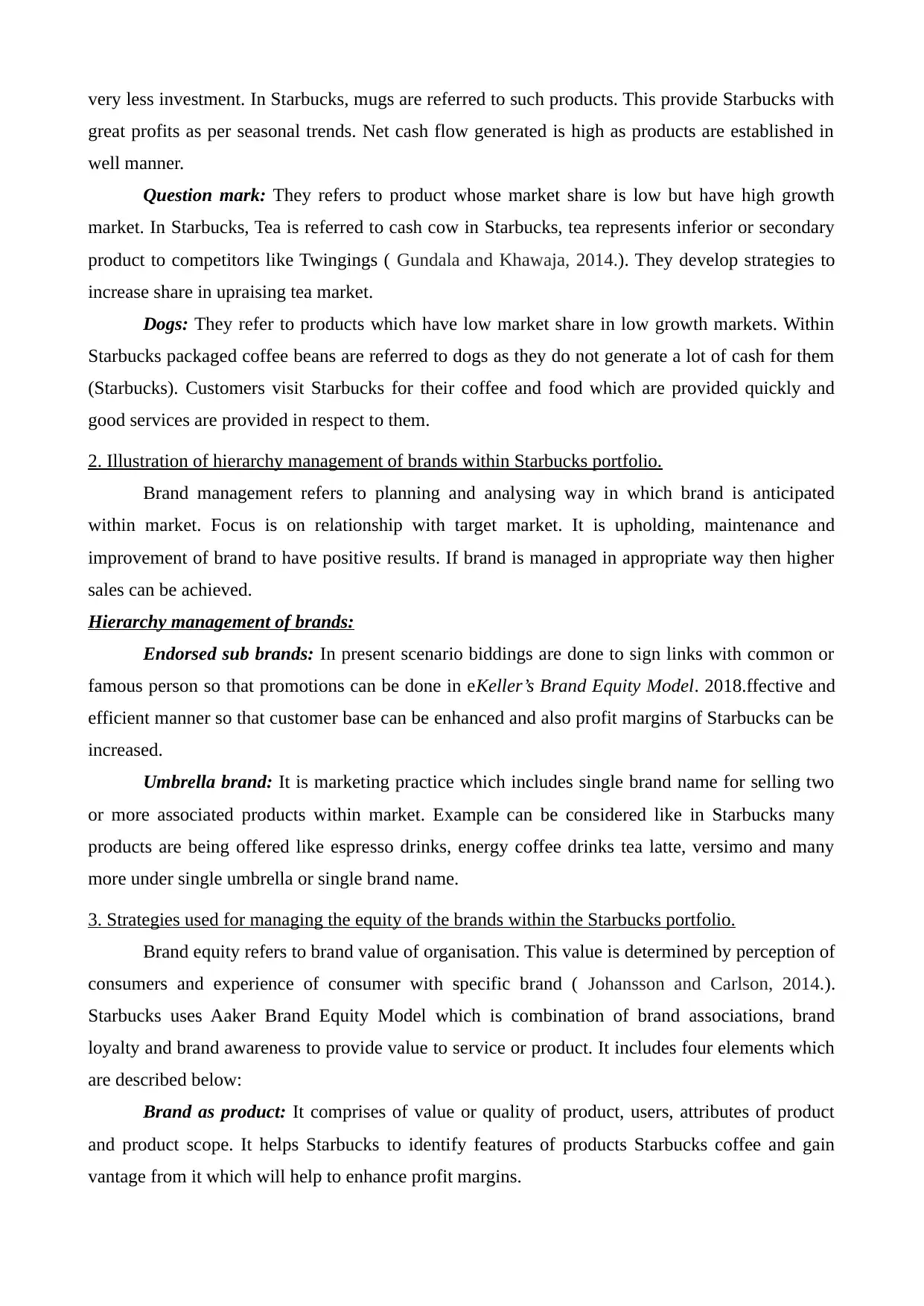
very less investment. In Starbucks, mugs are referred to such products. This provide Starbucks with
great profits as per seasonal trends. Net cash flow generated is high as products are established in
well manner.
Question mark: They refers to product whose market share is low but have high growth
market. In Starbucks, Tea is referred to cash cow in Starbucks, tea represents inferior or secondary
product to competitors like Twingings ( Gundala and Khawaja, 2014.). They develop strategies to
increase share in upraising tea market.
Dogs: They refer to products which have low market share in low growth markets. Within
Starbucks packaged coffee beans are referred to dogs as they do not generate a lot of cash for them
(Starbucks). Customers visit Starbucks for their coffee and food which are provided quickly and
good services are provided in respect to them.
2. Illustration of hierarchy management of brands within Starbucks portfolio.
Brand management refers to planning and analysing way in which brand is anticipated
within market. Focus is on relationship with target market. It is upholding, maintenance and
improvement of brand to have positive results. If brand is managed in appropriate way then higher
sales can be achieved.
Hierarchy management of brands:
Endorsed sub brands: In present scenario biddings are done to sign links with common or
famous person so that promotions can be done in eKeller’s Brand Equity Model. 2018.ffective and
efficient manner so that customer base can be enhanced and also profit margins of Starbucks can be
increased.
Umbrella brand: It is marketing practice which includes single brand name for selling two
or more associated products within market. Example can be considered like in Starbucks many
products are being offered like espresso drinks, energy coffee drinks tea latte, versimo and many
more under single umbrella or single brand name.
3. Strategies used for managing the equity of the brands within the Starbucks portfolio.
Brand equity refers to brand value of organisation. This value is determined by perception of
consumers and experience of consumer with specific brand ( Johansson and Carlson, 2014.).
Starbucks uses Aaker Brand Equity Model which is combination of brand associations, brand
loyalty and brand awareness to provide value to service or product. It includes four elements which
are described below:
Brand as product: It comprises of value or quality of product, users, attributes of product
and product scope. It helps Starbucks to identify features of products Starbucks coffee and gain
vantage from it which will help to enhance profit margins.
great profits as per seasonal trends. Net cash flow generated is high as products are established in
well manner.
Question mark: They refers to product whose market share is low but have high growth
market. In Starbucks, Tea is referred to cash cow in Starbucks, tea represents inferior or secondary
product to competitors like Twingings ( Gundala and Khawaja, 2014.). They develop strategies to
increase share in upraising tea market.
Dogs: They refer to products which have low market share in low growth markets. Within
Starbucks packaged coffee beans are referred to dogs as they do not generate a lot of cash for them
(Starbucks). Customers visit Starbucks for their coffee and food which are provided quickly and
good services are provided in respect to them.
2. Illustration of hierarchy management of brands within Starbucks portfolio.
Brand management refers to planning and analysing way in which brand is anticipated
within market. Focus is on relationship with target market. It is upholding, maintenance and
improvement of brand to have positive results. If brand is managed in appropriate way then higher
sales can be achieved.
Hierarchy management of brands:
Endorsed sub brands: In present scenario biddings are done to sign links with common or
famous person so that promotions can be done in eKeller’s Brand Equity Model. 2018.ffective and
efficient manner so that customer base can be enhanced and also profit margins of Starbucks can be
increased.
Umbrella brand: It is marketing practice which includes single brand name for selling two
or more associated products within market. Example can be considered like in Starbucks many
products are being offered like espresso drinks, energy coffee drinks tea latte, versimo and many
more under single umbrella or single brand name.
3. Strategies used for managing the equity of the brands within the Starbucks portfolio.
Brand equity refers to brand value of organisation. This value is determined by perception of
consumers and experience of consumer with specific brand ( Johansson and Carlson, 2014.).
Starbucks uses Aaker Brand Equity Model which is combination of brand associations, brand
loyalty and brand awareness to provide value to service or product. It includes four elements which
are described below:
Brand as product: It comprises of value or quality of product, users, attributes of product
and product scope. It helps Starbucks to identify features of products Starbucks coffee and gain
vantage from it which will help to enhance profit margins.
Paraphrase This Document
Need a fresh take? Get an instant paraphrase of this document with our AI Paraphraser
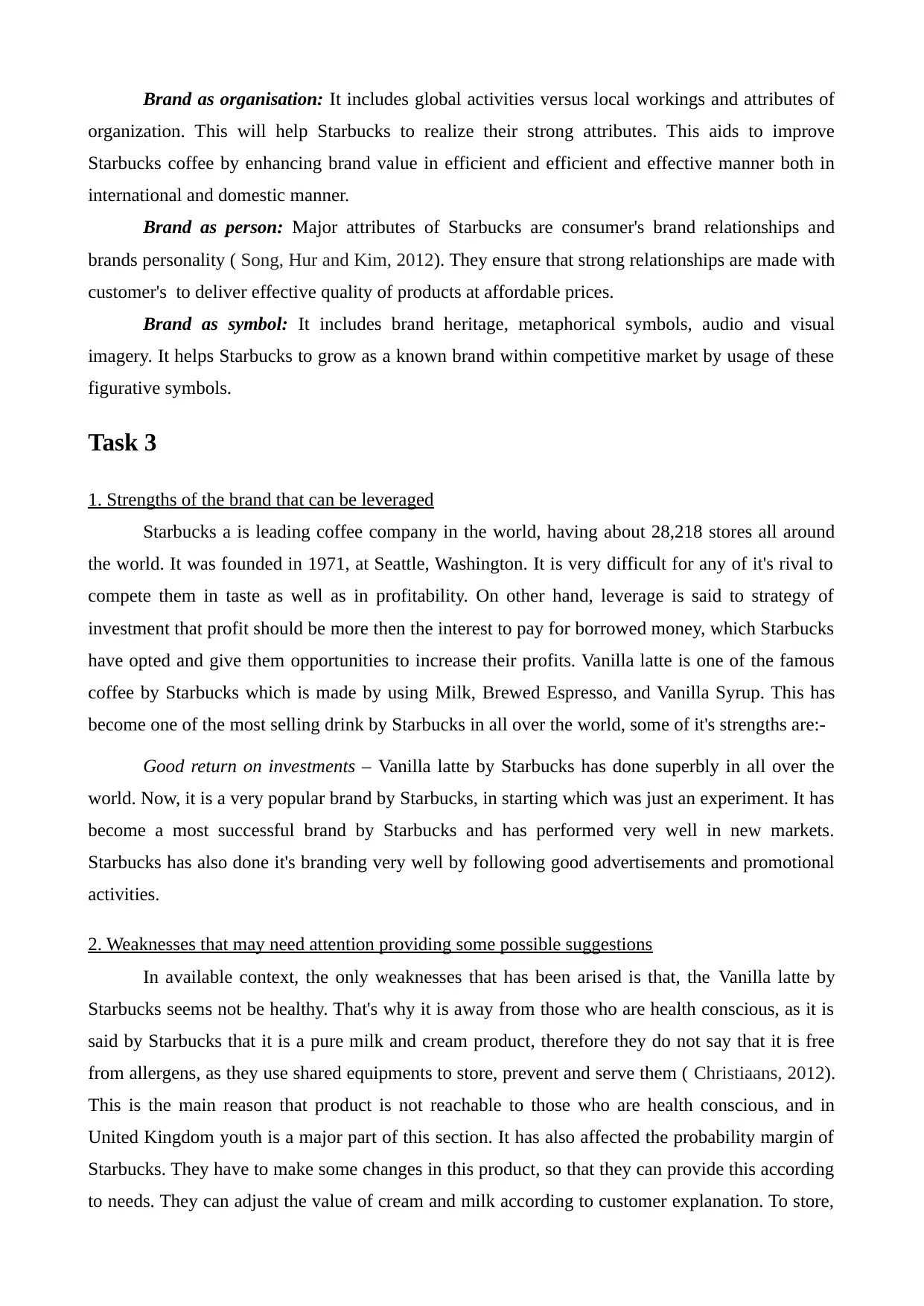
Brand as organisation: It includes global activities versus local workings and attributes of
organization. This will help Starbucks to realize their strong attributes. This aids to improve
Starbucks coffee by enhancing brand value in efficient and efficient and effective manner both in
international and domestic manner.
Brand as person: Major attributes of Starbucks are consumer's brand relationships and
brands personality ( Song, Hur and Kim, 2012). They ensure that strong relationships are made with
customer's to deliver effective quality of products at affordable prices.
Brand as symbol: It includes brand heritage, metaphorical symbols, audio and visual
imagery. It helps Starbucks to grow as a known brand within competitive market by usage of these
figurative symbols.
Task 3
1. Strengths of the brand that can be leveraged
Starbucks a is leading coffee company in the world, having about 28,218 stores all around
the world. It was founded in 1971, at Seattle, Washington. It is very difficult for any of it's rival to
compete them in taste as well as in profitability. On other hand, leverage is said to strategy of
investment that profit should be more then the interest to pay for borrowed money, which Starbucks
have opted and give them opportunities to increase their profits. Vanilla latte is one of the famous
coffee by Starbucks which is made by using Milk, Brewed Espresso, and Vanilla Syrup. This has
become one of the most selling drink by Starbucks in all over the world, some of it's strengths are:-
Good return on investments – Vanilla latte by Starbucks has done superbly in all over the
world. Now, it is a very popular brand by Starbucks, in starting which was just an experiment. It has
become a most successful brand by Starbucks and has performed very well in new markets.
Starbucks has also done it's branding very well by following good advertisements and promotional
activities.
2. Weaknesses that may need attention providing some possible suggestions
In available context, the only weaknesses that has been arised is that, the Vanilla latte by
Starbucks seems not be healthy. That's why it is away from those who are health conscious, as it is
said by Starbucks that it is a pure milk and cream product, therefore they do not say that it is free
from allergens, as they use shared equipments to store, prevent and serve them ( Christiaans, 2012).
This is the main reason that product is not reachable to those who are health conscious, and in
United Kingdom youth is a major part of this section. It has also affected the probability margin of
Starbucks. They have to make some changes in this product, so that they can provide this according
to needs. They can adjust the value of cream and milk according to customer explanation. To store,
organization. This will help Starbucks to realize their strong attributes. This aids to improve
Starbucks coffee by enhancing brand value in efficient and efficient and effective manner both in
international and domestic manner.
Brand as person: Major attributes of Starbucks are consumer's brand relationships and
brands personality ( Song, Hur and Kim, 2012). They ensure that strong relationships are made with
customer's to deliver effective quality of products at affordable prices.
Brand as symbol: It includes brand heritage, metaphorical symbols, audio and visual
imagery. It helps Starbucks to grow as a known brand within competitive market by usage of these
figurative symbols.
Task 3
1. Strengths of the brand that can be leveraged
Starbucks a is leading coffee company in the world, having about 28,218 stores all around
the world. It was founded in 1971, at Seattle, Washington. It is very difficult for any of it's rival to
compete them in taste as well as in profitability. On other hand, leverage is said to strategy of
investment that profit should be more then the interest to pay for borrowed money, which Starbucks
have opted and give them opportunities to increase their profits. Vanilla latte is one of the famous
coffee by Starbucks which is made by using Milk, Brewed Espresso, and Vanilla Syrup. This has
become one of the most selling drink by Starbucks in all over the world, some of it's strengths are:-
Good return on investments – Vanilla latte by Starbucks has done superbly in all over the
world. Now, it is a very popular brand by Starbucks, in starting which was just an experiment. It has
become a most successful brand by Starbucks and has performed very well in new markets.
Starbucks has also done it's branding very well by following good advertisements and promotional
activities.
2. Weaknesses that may need attention providing some possible suggestions
In available context, the only weaknesses that has been arised is that, the Vanilla latte by
Starbucks seems not be healthy. That's why it is away from those who are health conscious, as it is
said by Starbucks that it is a pure milk and cream product, therefore they do not say that it is free
from allergens, as they use shared equipments to store, prevent and serve them ( Christiaans, 2012).
This is the main reason that product is not reachable to those who are health conscious, and in
United Kingdom youth is a major part of this section. It has also affected the probability margin of
Starbucks. They have to make some changes in this product, so that they can provide this according
to needs. They can adjust the value of cream and milk according to customer explanation. To store,
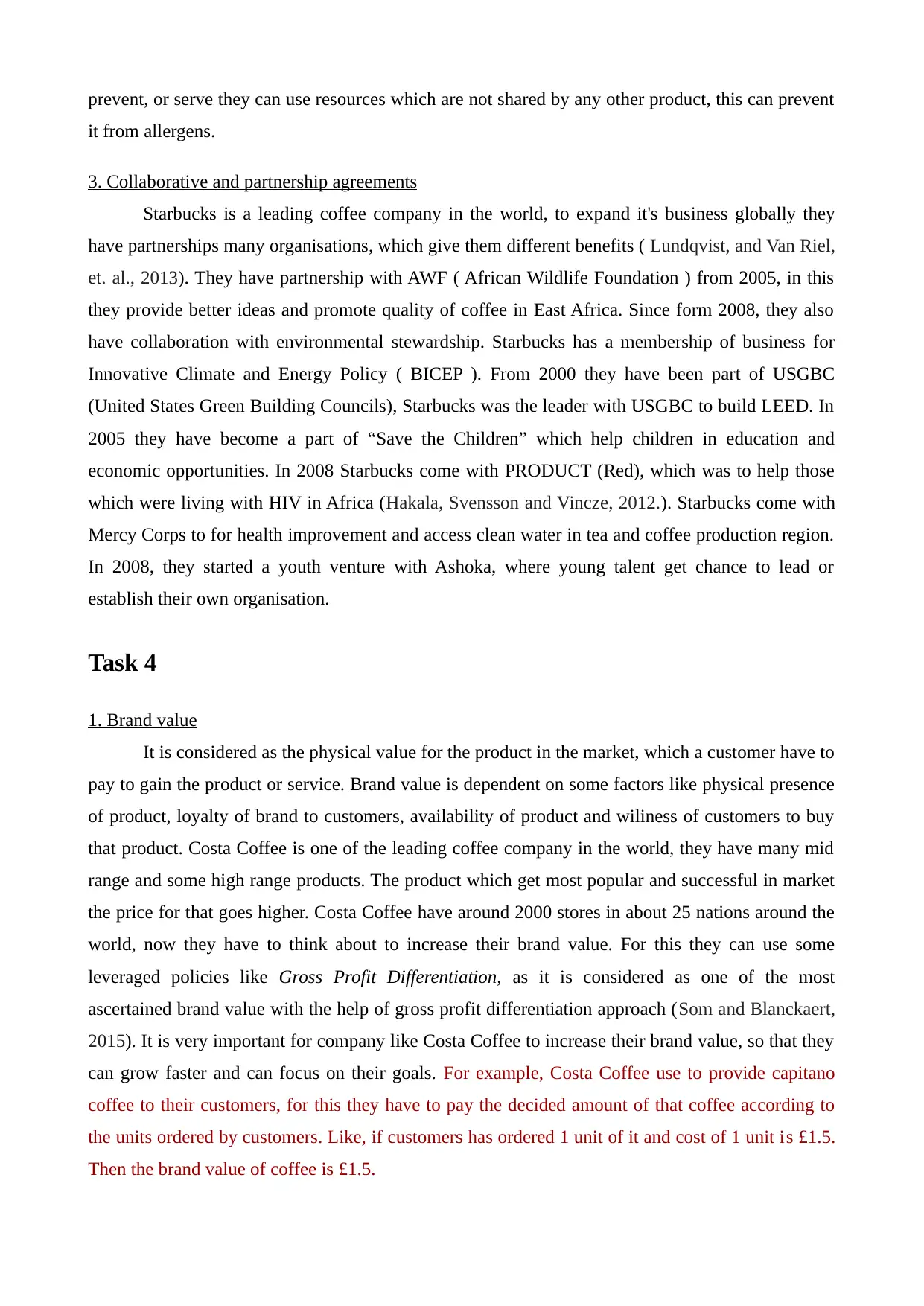
prevent, or serve they can use resources which are not shared by any other product, this can prevent
it from allergens.
3. Collaborative and partnership agreements
Starbucks is a leading coffee company in the world, to expand it's business globally they
have partnerships many organisations, which give them different benefits ( Lundqvist, and Van Riel,
et. al., 2013). They have partnership with AWF ( African Wildlife Foundation ) from 2005, in this
they provide better ideas and promote quality of coffee in East Africa. Since form 2008, they also
have collaboration with environmental stewardship. Starbucks has a membership of business for
Innovative Climate and Energy Policy ( BICEP ). From 2000 they have been part of USGBC
(United States Green Building Councils), Starbucks was the leader with USGBC to build LEED. In
2005 they have become a part of “Save the Children” which help children in education and
economic opportunities. In 2008 Starbucks come with PRODUCT (Red), which was to help those
which were living with HIV in Africa (Hakala, Svensson and Vincze, 2012.). Starbucks come with
Mercy Corps to for health improvement and access clean water in tea and coffee production region.
In 2008, they started a youth venture with Ashoka, where young talent get chance to lead or
establish their own organisation.
Task 4
1. Brand value
It is considered as the physical value for the product in the market, which a customer have to
pay to gain the product or service. Brand value is dependent on some factors like physical presence
of product, loyalty of brand to customers, availability of product and wiliness of customers to buy
that product. Costa Coffee is one of the leading coffee company in the world, they have many mid
range and some high range products. The product which get most popular and successful in market
the price for that goes higher. Costa Coffee have around 2000 stores in about 25 nations around the
world, now they have to think about to increase their brand value. For this they can use some
leveraged policies like Gross Profit Differentiation, as it is considered as one of the most
ascertained brand value with the help of gross profit differentiation approach (Som and Blanckaert,
2015). It is very important for company like Costa Coffee to increase their brand value, so that they
can grow faster and can focus on their goals. For example, Costa Coffee use to provide capitano
coffee to their customers, for this they have to pay the decided amount of that coffee according to
the units ordered by customers. Like, if customers has ordered 1 unit of it and cost of 1 unit is £1.5.
Then the brand value of coffee is £1.5.
it from allergens.
3. Collaborative and partnership agreements
Starbucks is a leading coffee company in the world, to expand it's business globally they
have partnerships many organisations, which give them different benefits ( Lundqvist, and Van Riel,
et. al., 2013). They have partnership with AWF ( African Wildlife Foundation ) from 2005, in this
they provide better ideas and promote quality of coffee in East Africa. Since form 2008, they also
have collaboration with environmental stewardship. Starbucks has a membership of business for
Innovative Climate and Energy Policy ( BICEP ). From 2000 they have been part of USGBC
(United States Green Building Councils), Starbucks was the leader with USGBC to build LEED. In
2005 they have become a part of “Save the Children” which help children in education and
economic opportunities. In 2008 Starbucks come with PRODUCT (Red), which was to help those
which were living with HIV in Africa (Hakala, Svensson and Vincze, 2012.). Starbucks come with
Mercy Corps to for health improvement and access clean water in tea and coffee production region.
In 2008, they started a youth venture with Ashoka, where young talent get chance to lead or
establish their own organisation.
Task 4
1. Brand value
It is considered as the physical value for the product in the market, which a customer have to
pay to gain the product or service. Brand value is dependent on some factors like physical presence
of product, loyalty of brand to customers, availability of product and wiliness of customers to buy
that product. Costa Coffee is one of the leading coffee company in the world, they have many mid
range and some high range products. The product which get most popular and successful in market
the price for that goes higher. Costa Coffee have around 2000 stores in about 25 nations around the
world, now they have to think about to increase their brand value. For this they can use some
leveraged policies like Gross Profit Differentiation, as it is considered as one of the most
ascertained brand value with the help of gross profit differentiation approach (Som and Blanckaert,
2015). It is very important for company like Costa Coffee to increase their brand value, so that they
can grow faster and can focus on their goals. For example, Costa Coffee use to provide capitano
coffee to their customers, for this they have to pay the decided amount of that coffee according to
the units ordered by customers. Like, if customers has ordered 1 unit of it and cost of 1 unit is £1.5.
Then the brand value of coffee is £1.5.
⊘ This is a preview!⊘
Do you want full access?
Subscribe today to unlock all pages.

Trusted by 1+ million students worldwide
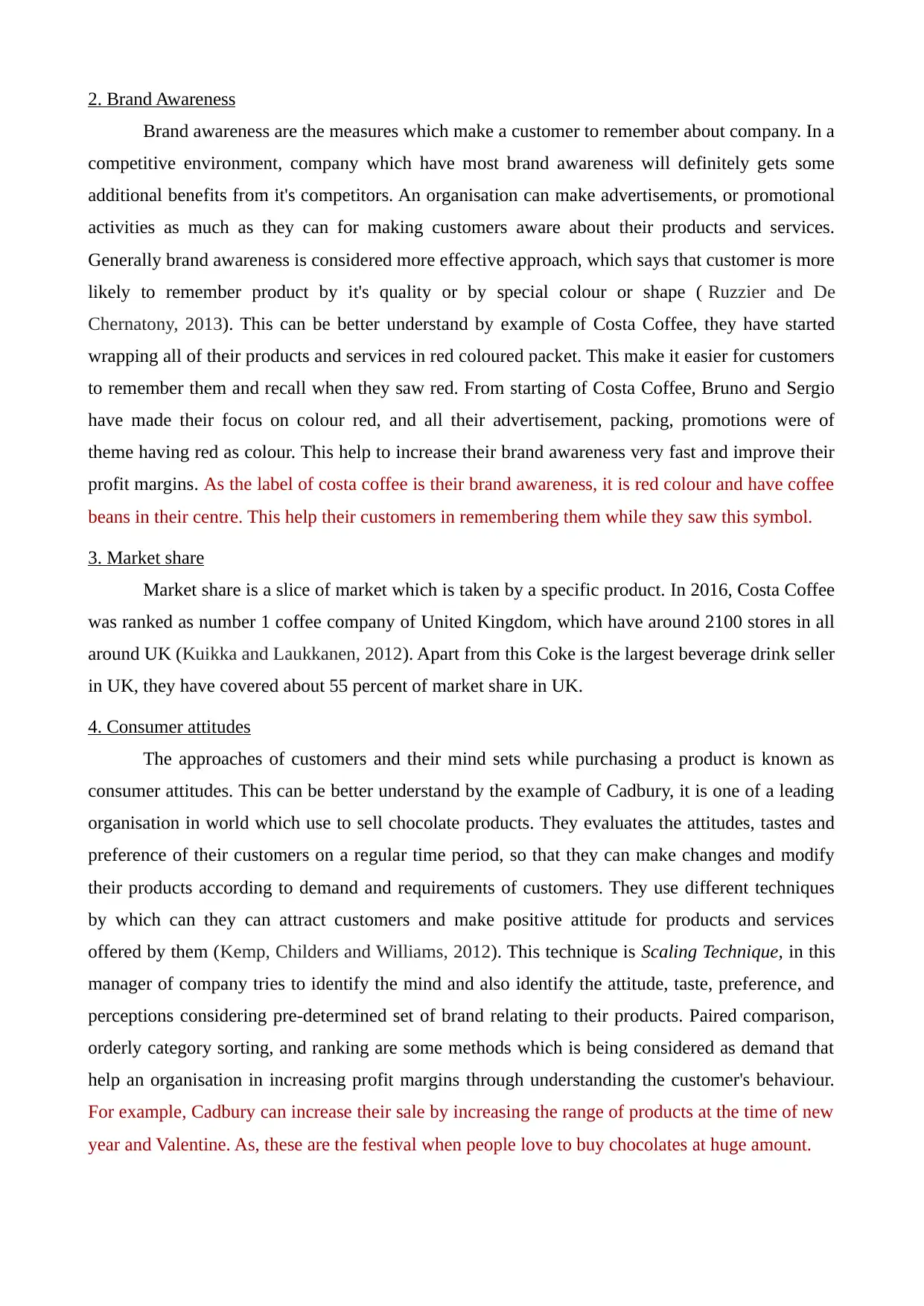
2. Brand Awareness
Brand awareness are the measures which make a customer to remember about company. In a
competitive environment, company which have most brand awareness will definitely gets some
additional benefits from it's competitors. An organisation can make advertisements, or promotional
activities as much as they can for making customers aware about their products and services.
Generally brand awareness is considered more effective approach, which says that customer is more
likely to remember product by it's quality or by special colour or shape ( Ruzzier and De
Chernatony, 2013). This can be better understand by example of Costa Coffee, they have started
wrapping all of their products and services in red coloured packet. This make it easier for customers
to remember them and recall when they saw red. From starting of Costa Coffee, Bruno and Sergio
have made their focus on colour red, and all their advertisement, packing, promotions were of
theme having red as colour. This help to increase their brand awareness very fast and improve their
profit margins. As the label of costa coffee is their brand awareness, it is red colour and have coffee
beans in their centre. This help their customers in remembering them while they saw this symbol.
3. Market share
Market share is a slice of market which is taken by a specific product. In 2016, Costa Coffee
was ranked as number 1 coffee company of United Kingdom, which have around 2100 stores in all
around UK (Kuikka and Laukkanen, 2012). Apart from this Coke is the largest beverage drink seller
in UK, they have covered about 55 percent of market share in UK.
4. Consumer attitudes
The approaches of customers and their mind sets while purchasing a product is known as
consumer attitudes. This can be better understand by the example of Cadbury, it is one of a leading
organisation in world which use to sell chocolate products. They evaluates the attitudes, tastes and
preference of their customers on a regular time period, so that they can make changes and modify
their products according to demand and requirements of customers. They use different techniques
by which can they can attract customers and make positive attitude for products and services
offered by them (Kemp, Childers and Williams, 2012). This technique is Scaling Technique, in this
manager of company tries to identify the mind and also identify the attitude, taste, preference, and
perceptions considering pre-determined set of brand relating to their products. Paired comparison,
orderly category sorting, and ranking are some methods which is being considered as demand that
help an organisation in increasing profit margins through understanding the customer's behaviour.
For example, Cadbury can increase their sale by increasing the range of products at the time of new
year and Valentine. As, these are the festival when people love to buy chocolates at huge amount.
Brand awareness are the measures which make a customer to remember about company. In a
competitive environment, company which have most brand awareness will definitely gets some
additional benefits from it's competitors. An organisation can make advertisements, or promotional
activities as much as they can for making customers aware about their products and services.
Generally brand awareness is considered more effective approach, which says that customer is more
likely to remember product by it's quality or by special colour or shape ( Ruzzier and De
Chernatony, 2013). This can be better understand by example of Costa Coffee, they have started
wrapping all of their products and services in red coloured packet. This make it easier for customers
to remember them and recall when they saw red. From starting of Costa Coffee, Bruno and Sergio
have made their focus on colour red, and all their advertisement, packing, promotions were of
theme having red as colour. This help to increase their brand awareness very fast and improve their
profit margins. As the label of costa coffee is their brand awareness, it is red colour and have coffee
beans in their centre. This help their customers in remembering them while they saw this symbol.
3. Market share
Market share is a slice of market which is taken by a specific product. In 2016, Costa Coffee
was ranked as number 1 coffee company of United Kingdom, which have around 2100 stores in all
around UK (Kuikka and Laukkanen, 2012). Apart from this Coke is the largest beverage drink seller
in UK, they have covered about 55 percent of market share in UK.
4. Consumer attitudes
The approaches of customers and their mind sets while purchasing a product is known as
consumer attitudes. This can be better understand by the example of Cadbury, it is one of a leading
organisation in world which use to sell chocolate products. They evaluates the attitudes, tastes and
preference of their customers on a regular time period, so that they can make changes and modify
their products according to demand and requirements of customers. They use different techniques
by which can they can attract customers and make positive attitude for products and services
offered by them (Kemp, Childers and Williams, 2012). This technique is Scaling Technique, in this
manager of company tries to identify the mind and also identify the attitude, taste, preference, and
perceptions considering pre-determined set of brand relating to their products. Paired comparison,
orderly category sorting, and ranking are some methods which is being considered as demand that
help an organisation in increasing profit margins through understanding the customer's behaviour.
For example, Cadbury can increase their sale by increasing the range of products at the time of new
year and Valentine. As, these are the festival when people love to buy chocolates at huge amount.
Paraphrase This Document
Need a fresh take? Get an instant paraphrase of this document with our AI Paraphraser
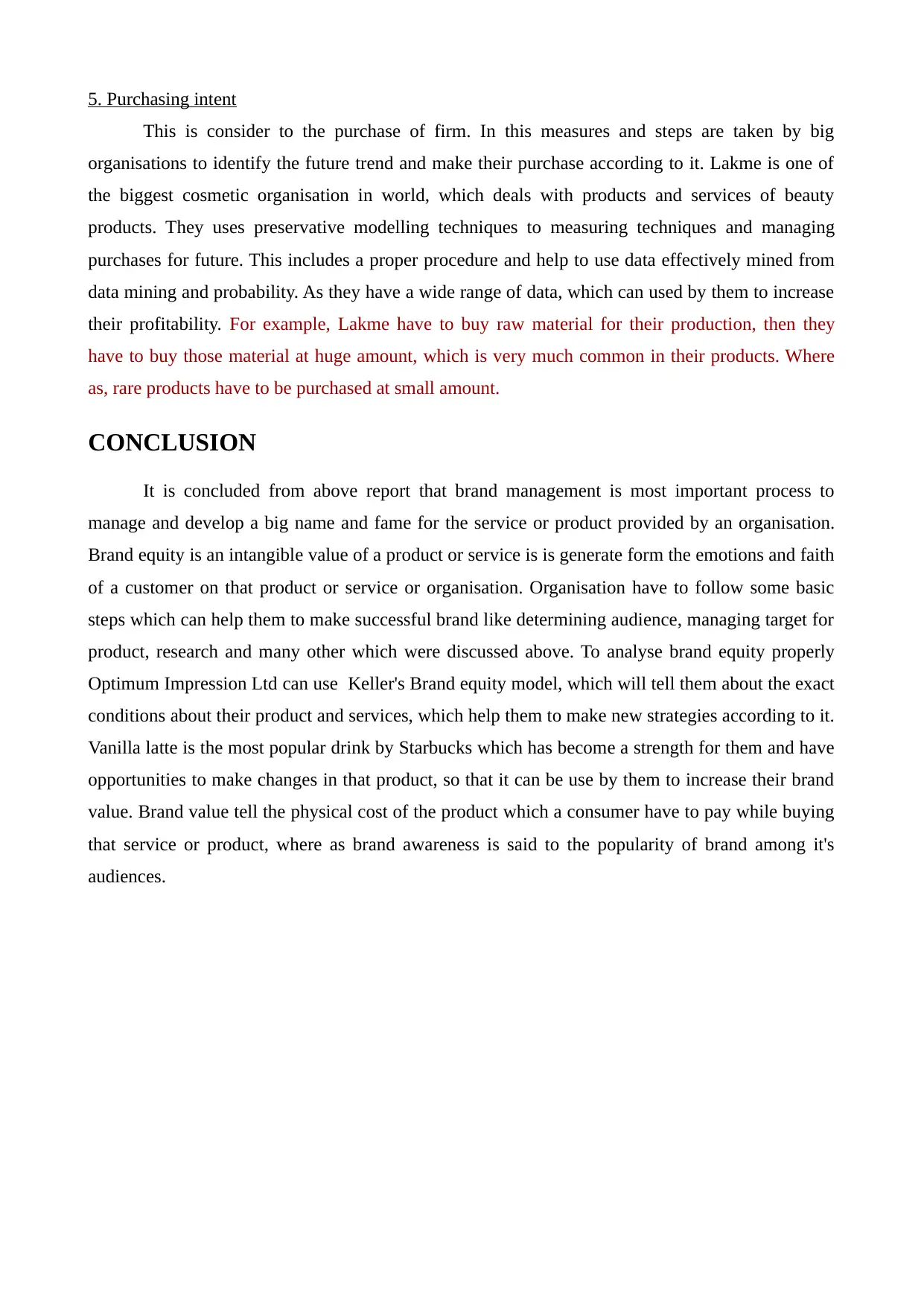
5. Purchasing intent
This is consider to the purchase of firm. In this measures and steps are taken by big
organisations to identify the future trend and make their purchase according to it. Lakme is one of
the biggest cosmetic organisation in world, which deals with products and services of beauty
products. They uses preservative modelling techniques to measuring techniques and managing
purchases for future. This includes a proper procedure and help to use data effectively mined from
data mining and probability. As they have a wide range of data, which can used by them to increase
their profitability. For example, Lakme have to buy raw material for their production, then they
have to buy those material at huge amount, which is very much common in their products. Where
as, rare products have to be purchased at small amount.
CONCLUSION
It is concluded from above report that brand management is most important process to
manage and develop a big name and fame for the service or product provided by an organisation.
Brand equity is an intangible value of a product or service is is generate form the emotions and faith
of a customer on that product or service or organisation. Organisation have to follow some basic
steps which can help them to make successful brand like determining audience, managing target for
product, research and many other which were discussed above. To analyse brand equity properly
Optimum Impression Ltd can use Keller's Brand equity model, which will tell them about the exact
conditions about their product and services, which help them to make new strategies according to it.
Vanilla latte is the most popular drink by Starbucks which has become a strength for them and have
opportunities to make changes in that product, so that it can be use by them to increase their brand
value. Brand value tell the physical cost of the product which a consumer have to pay while buying
that service or product, where as brand awareness is said to the popularity of brand among it's
audiences.
This is consider to the purchase of firm. In this measures and steps are taken by big
organisations to identify the future trend and make their purchase according to it. Lakme is one of
the biggest cosmetic organisation in world, which deals with products and services of beauty
products. They uses preservative modelling techniques to measuring techniques and managing
purchases for future. This includes a proper procedure and help to use data effectively mined from
data mining and probability. As they have a wide range of data, which can used by them to increase
their profitability. For example, Lakme have to buy raw material for their production, then they
have to buy those material at huge amount, which is very much common in their products. Where
as, rare products have to be purchased at small amount.
CONCLUSION
It is concluded from above report that brand management is most important process to
manage and develop a big name and fame for the service or product provided by an organisation.
Brand equity is an intangible value of a product or service is is generate form the emotions and faith
of a customer on that product or service or organisation. Organisation have to follow some basic
steps which can help them to make successful brand like determining audience, managing target for
product, research and many other which were discussed above. To analyse brand equity properly
Optimum Impression Ltd can use Keller's Brand equity model, which will tell them about the exact
conditions about their product and services, which help them to make new strategies according to it.
Vanilla latte is the most popular drink by Starbucks which has become a strength for them and have
opportunities to make changes in that product, so that it can be use by them to increase their brand
value. Brand value tell the physical cost of the product which a consumer have to pay while buying
that service or product, where as brand awareness is said to the popularity of brand among it's
audiences.
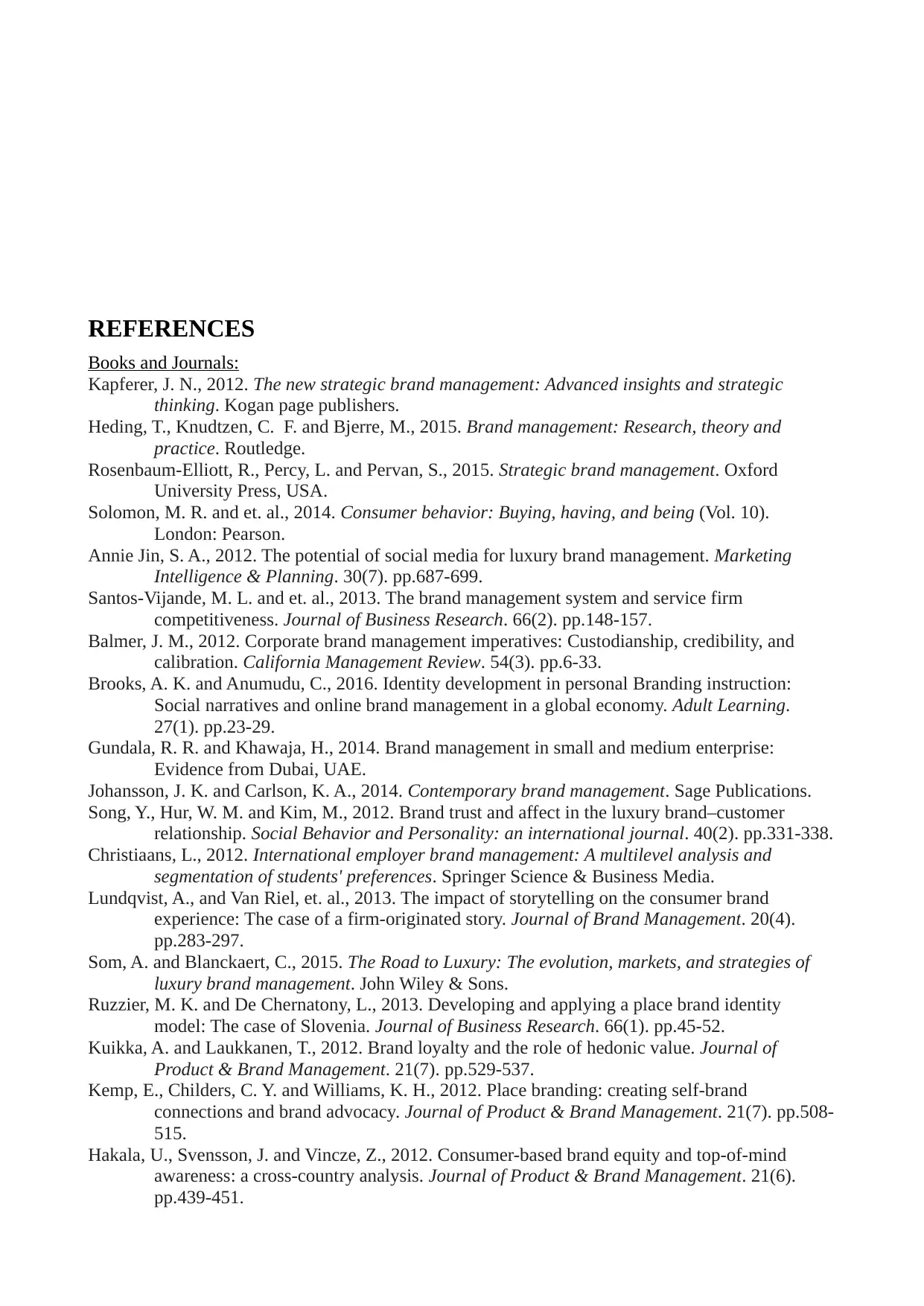
REFERENCES
Books and Journals:
Kapferer, J. N., 2012. The new strategic brand management: Advanced insights and strategic
thinking. Kogan page publishers.
Heding, T., Knudtzen, C. F. and Bjerre, M., 2015. Brand management: Research, theory and
practice. Routledge.
Rosenbaum-Elliott, R., Percy, L. and Pervan, S., 2015. Strategic brand management. Oxford
University Press, USA.
Solomon, M. R. and et. al., 2014. Consumer behavior: Buying, having, and being (Vol. 10).
London: Pearson.
Annie Jin, S. A., 2012. The potential of social media for luxury brand management. Marketing
Intelligence & Planning. 30(7). pp.687-699.
Santos-Vijande, M. L. and et. al., 2013. The brand management system and service firm
competitiveness. Journal of Business Research. 66(2). pp.148-157.
Balmer, J. M., 2012. Corporate brand management imperatives: Custodianship, credibility, and
calibration. California Management Review. 54(3). pp.6-33.
Brooks, A. K. and Anumudu, C., 2016. Identity development in personal Branding instruction:
Social narratives and online brand management in a global economy. Adult Learning.
27(1). pp.23-29.
Gundala, R. R. and Khawaja, H., 2014. Brand management in small and medium enterprise:
Evidence from Dubai, UAE.
Johansson, J. K. and Carlson, K. A., 2014. Contemporary brand management. Sage Publications.
Song, Y., Hur, W. M. and Kim, M., 2012. Brand trust and affect in the luxury brand–customer
relationship. Social Behavior and Personality: an international journal. 40(2). pp.331-338.
Christiaans, L., 2012. International employer brand management: A multilevel analysis and
segmentation of students' preferences. Springer Science & Business Media.
Lundqvist, A., and Van Riel, et. al., 2013. The impact of storytelling on the consumer brand
experience: The case of a firm-originated story. Journal of Brand Management. 20(4).
pp.283-297.
Som, A. and Blanckaert, C., 2015. The Road to Luxury: The evolution, markets, and strategies of
luxury brand management. John Wiley & Sons.
Ruzzier, M. K. and De Chernatony, L., 2013. Developing and applying a place brand identity
model: The case of Slovenia. Journal of Business Research. 66(1). pp.45-52.
Kuikka, A. and Laukkanen, T., 2012. Brand loyalty and the role of hedonic value. Journal of
Product & Brand Management. 21(7). pp.529-537.
Kemp, E., Childers, C. Y. and Williams, K. H., 2012. Place branding: creating self-brand
connections and brand advocacy. Journal of Product & Brand Management. 21(7). pp.508-
515.
Hakala, U., Svensson, J. and Vincze, Z., 2012. Consumer-based brand equity and top-of-mind
awareness: a cross-country analysis. Journal of Product & Brand Management. 21(6).
pp.439-451.
Books and Journals:
Kapferer, J. N., 2012. The new strategic brand management: Advanced insights and strategic
thinking. Kogan page publishers.
Heding, T., Knudtzen, C. F. and Bjerre, M., 2015. Brand management: Research, theory and
practice. Routledge.
Rosenbaum-Elliott, R., Percy, L. and Pervan, S., 2015. Strategic brand management. Oxford
University Press, USA.
Solomon, M. R. and et. al., 2014. Consumer behavior: Buying, having, and being (Vol. 10).
London: Pearson.
Annie Jin, S. A., 2012. The potential of social media for luxury brand management. Marketing
Intelligence & Planning. 30(7). pp.687-699.
Santos-Vijande, M. L. and et. al., 2013. The brand management system and service firm
competitiveness. Journal of Business Research. 66(2). pp.148-157.
Balmer, J. M., 2012. Corporate brand management imperatives: Custodianship, credibility, and
calibration. California Management Review. 54(3). pp.6-33.
Brooks, A. K. and Anumudu, C., 2016. Identity development in personal Branding instruction:
Social narratives and online brand management in a global economy. Adult Learning.
27(1). pp.23-29.
Gundala, R. R. and Khawaja, H., 2014. Brand management in small and medium enterprise:
Evidence from Dubai, UAE.
Johansson, J. K. and Carlson, K. A., 2014. Contemporary brand management. Sage Publications.
Song, Y., Hur, W. M. and Kim, M., 2012. Brand trust and affect in the luxury brand–customer
relationship. Social Behavior and Personality: an international journal. 40(2). pp.331-338.
Christiaans, L., 2012. International employer brand management: A multilevel analysis and
segmentation of students' preferences. Springer Science & Business Media.
Lundqvist, A., and Van Riel, et. al., 2013. The impact of storytelling on the consumer brand
experience: The case of a firm-originated story. Journal of Brand Management. 20(4).
pp.283-297.
Som, A. and Blanckaert, C., 2015. The Road to Luxury: The evolution, markets, and strategies of
luxury brand management. John Wiley & Sons.
Ruzzier, M. K. and De Chernatony, L., 2013. Developing and applying a place brand identity
model: The case of Slovenia. Journal of Business Research. 66(1). pp.45-52.
Kuikka, A. and Laukkanen, T., 2012. Brand loyalty and the role of hedonic value. Journal of
Product & Brand Management. 21(7). pp.529-537.
Kemp, E., Childers, C. Y. and Williams, K. H., 2012. Place branding: creating self-brand
connections and brand advocacy. Journal of Product & Brand Management. 21(7). pp.508-
515.
Hakala, U., Svensson, J. and Vincze, Z., 2012. Consumer-based brand equity and top-of-mind
awareness: a cross-country analysis. Journal of Product & Brand Management. 21(6).
pp.439-451.
⊘ This is a preview!⊘
Do you want full access?
Subscribe today to unlock all pages.

Trusted by 1+ million students worldwide
1 out of 13
Related Documents
Your All-in-One AI-Powered Toolkit for Academic Success.
+13062052269
info@desklib.com
Available 24*7 on WhatsApp / Email
![[object Object]](/_next/static/media/star-bottom.7253800d.svg)
Unlock your academic potential
Copyright © 2020–2025 A2Z Services. All Rights Reserved. Developed and managed by ZUCOL.





